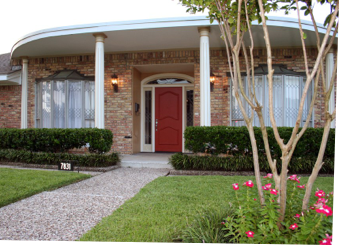7831 Santa Elena
Nicastro House
Built 1965
Architect: Dorothy Andrews
7831 Santa Elena Street (located at the north-east corner of Santa Elena Street and Broadway Blvd.) is a single story, mid-century Colonial residence that was designed by Houston-based architect Dorothy Andrews in 1964. The home was built for Larry and Josephine Nicastro, and it was completed in early December of 1965.
The general contractors that built the residence were Leon Campise and homeowner Larry Nicastro, who also built two other homes in Glenbrook Valley prior to this home. They built the Louis Francescon residence at 8115 Glencrest, and the Vance Saladino residence at 8119 Glencrest, both in 1954.
Larry and Josephine Nicastro relocated to Glenbrook Valley from 2915 Leek Street (located between the Gulf Freeway and Elgin Road, off Cullen Blvd. in the University of Houston area) with their daughter, Julia. They chose Glenbrook Valley, also known as “The Little River Oaks,” to build their new home because of the large number of Italian families that had built in, and relocated to, the neighborhood.
The 3100 square foot home was planned to impress, and with large family gatherings in mind. It includes many features that were undoubtedly exceptional in 1964. Features include:
- Extensive poured Italian marble terrazzo floors.
- A large formal living room, dining room, and an oversized den with a wall-scaled fireplace, wood box, and mantel.
- A large, primary electric kitchen with a walk-in pantry, double ovens, a surface mounted blender/mixer and wall-recessed paper towel, foil, and plastic wrap spools.
- Secondary gas kitchen adjacent to the main kitchen that is also a laundry room. All cabinetry and paneling were made on-site.
- Three bedroom suites, each with private bathrooms and walk-in closets. Two of the three private bathrooms originally featured floor sunken bathtubs.
- A prayer nook with an altar and stained glass window.
- An intercom and stereo system that includes wall and ceiling-recessed speakers.
- A detached office suite with a half-bath.
- Three full and two half bathrooms total.
- A three-car brick carport.
- A rounded and columned main elevation portico with leaded glass bay windows.
- An extensive stone-surfaced concrete driveway, sidewalks, and plant urns.
- A rear-elevation oversized covered porch that connects the office to the main house.
- An oversized hallway walk-in cedar closet.
In planning with their architect, the Nicastros both had strong opinions about what their new home should be, and ultimately agreed that Larry would make choices for the exterior of the house, and Josephine would make interior decisions. The youngest of the three Nicastro children, Julia, was attending Stephen F. Austin High School when their new house was being planned, and remembers her mother telling her father “the inside [planning] was HER baby.” Josephine researched style and decorating through home magazines and saved idea clippings and pictures for their architect throughout the planning.
The home was completed and moved into just before Christmas in 1965. Original décor included flocked wallpapers in the kitchen, dining room, and foyer, as well as a wall mural design by artist Roy Jacobs in Julia’s bedroom. Gold sculpted carpet originally ran throughout formals and bedrooms. The sunken bathtub, sink, and commode were lavender in Julia’s bathroom suite, yellow in Josephine’s, and Larry’s bathroom sink and commode were blue. Gold-plated fixtures and hardware were included in all bathrooms.
For the Nicastros, the house was genuinely a dream home, where they remained over the next four-plus decades. They enjoyed family gatherings with their three children, Larry, Joseph, and Julia; their children’s spouses; and their grandchildren and great-grandchildren.
Josephine enjoyed cooking for large family gatherings and preferred to reserve the use of her larger kitchen for holidays and special occasions. Day-to-day cooking and laundry happened in the secondary kitchen. Today, the original cabinetry, paneling, and white Formica counters that she selected for the main kitchen in 1964 remain in the pristine condition in which she maintained them.
Josephine was an avid gardener. The yard was regularly voted the Glenbrook Valley Yard of the Month, often in heated competition with longtime family friends and next-door neighbors, the John and Clara Gutierrez family.
Larry passed away on March 28, 1996, at the age of 86. Josephine continued to be independent and active well into her nineties, including volunteering at St Joseph’s Hospital and St. Christopher Catholic Church for many years. Josephine remained in the home until the age of 94. She resided at Brighton Gardens Bellaire Assisted Living Center for the last two years of her life, and died on November 4, 2009, at the age of 96.
Over the 40-plus years that the Nicastros resided at 7831 Santa Elena Street, little more than paint, wallpaper, and carpet were ever changed or modified. All original kitchen cabinetry, countertops, built-ins, and wall paneling remain intact. The original stamped architect drawings remain in exceptional condition in a detailed home archive.
The remarkably original and well-maintained residence was sold in September of 2009 to Theodore (Ted) Skibinski, a native of Ithaca, NY, who has worked and lived in Houston since 2000.
Over the past year, the home has undergone an architecturally sensitive renovation that has included:
- Full interior terrazzo restoration
- Extensive driveway restoration
- Removal of acoustical ceiling tiles throughout den, kitchen, and hallways
- One completely new bathroom, two updated (both retain original cabinetry, terrazzo floors, and wall tiles)
- Re-planning the back bedroom suite to accommodate a larger bathroom, and to gain backyard access from the rear bedroom
- Extensive interior and exterior painting and landscaping
Unique and exceptional in its own right, this residence is typical to what draws new residents to Glenbrook Valley. People who appreciate architecture and history appreciate this neighborhood, and it’s wealth of one-of-a-kind homes from the 1950s and 1960s.
For many years, the status of a Glenbrook Valley address had been long forgotten. Today, there is an emerging next generation of residents that are actively pushing the future of this neighborhood in a new direction.

